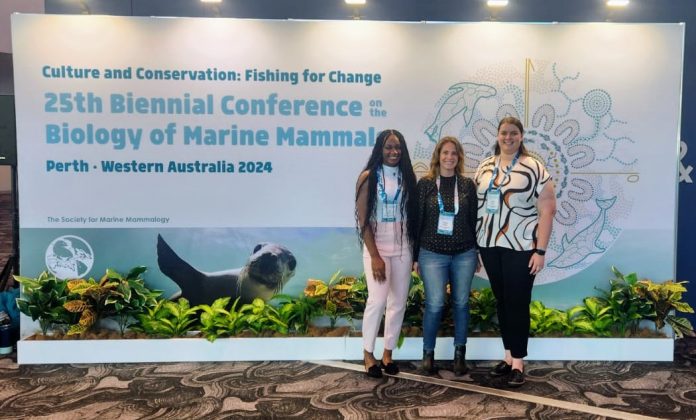Southern made a splash on the international stage recently, as faculty and graduate students presented groundbreaking research in November 2024 at the 25th Biennial Conference on the Biology of Marine Mammals (SMM2024) in Perth, Australia.
Dr. Meghan Barboza, professor of biology and an expert in marine mammal anatomy, attended alongside graduate students Lydia Masala and Allison Kross. Their research focused on the unique adaptations of harbor seals (Phoca vitulina) and showcased Southern’s contributions to understanding the biological intricacies of marine life.
“This conference was an extraordinary opportunity to share our work and engage with the global marine mammal research community,” said Barboza. “Collaborations like these showcase the power of interdisciplinary dialogue and the exciting potential for discovery.”
Below is an interview with Kross on her experiences in Australia.
Studying marine mammals often reveals unique adaptations for their aquatic environments. How do you think the differences in taste buds and tracheal structures between harbor seals, dogs, and manatees can help us better understand evolutionary adaptations?
AK: Understanding the differences in the trachea and taste buds between marine mammals, like harbor seals and manatees, and terrestrial mammals, like dogs, helps us identify the features that are important to each species. In our lab, we found no taste buds in harbor seals, which may suggest that taste buds were not evolutionarily significant for them, unlike their relatives, dogs, that have taste buds. In contrast, manatees, which also live in marine environments but spend time grazing on sea grasses in shallow waters, still have taste buds. This difference in diet and habitat may explain why manatees retain these structures, while harbor seals do not.
What was it like traveling across the world to Australia to present? Do you have any favorite moments from your time or research that capture the essence of studying marine mammals in their natural habitats?
AK: Traveling across the world to present in Australia was both exciting and tiring. It was such an amazing experience to be able to travel so far and meet so many new people who are also passionate about the same subject you are. But I won’t lie, flying for 25 hours straight is not for the faint of heart. My favorite moment from the conference was presenting my poster and research to my peers. I love to talk about my research, and hearing the insights my peers had was also helpful. As far as my research is concerned, I wish I could study harbor seals in their natural habitat, but as my work is histology-based, I spend all my time in the lab. I still enjoy the work though; anatomy and physiology are some of my favorite subjects in biology.
What do you enjoy most about researching marine mammals? Is there a specific aspect of the anatomy or behavior that fascinates you the most?
AK: The thing I enjoy most about researching marine mammals, and specifically my research where I am describing the tracheal anatomy of harbor seals, manatees, and common dolphins, is that not much research has been done on their tracheal anatomy. While this can make it challenging, I am stepping into the unknown and discovering some anatomical features for the first time. For example, in the harbor seal pup we looked at we found some large veins which are not common for seals. So, it’s really cool to look at and discover these new things that others have not found before.
For students or aspiring scientists interested in marine mammal research, what advice would you give them? Are there particular skills or areas of study that you’ve found especially valuable?
AK: My advice for any students or aspiring scientists who are interested in marine mammal research is to identify the specific skills or techniques you are interested in learning first. Think about if you want to do lab work or fieldwork. I initially was drawn to the research I am doing now because I wanted to learn the histology skills that my lab uses. For my specific research, I found classes like anatomy and physiology the most helpful, but biology and marine mammal science are still very broad topics, so a variety of classes can be helpful.
Collaboration aside, how has presenting your research at conferences or meetings helped shape your approach or provided new insights into your work?
AK: Presenting my research and attending the meeting in Australia allowed me to take a more holistic approach to my work. Before the meeting, I often worked in the lab with individual specimens, sometimes just small pieces of trachea, and it was easy to lose sight of the whole animal. Attending the meeting reminded me to consider the entire animal, including its behaviors and habits, and how these factors might influence the structures I observe in the trachea.


